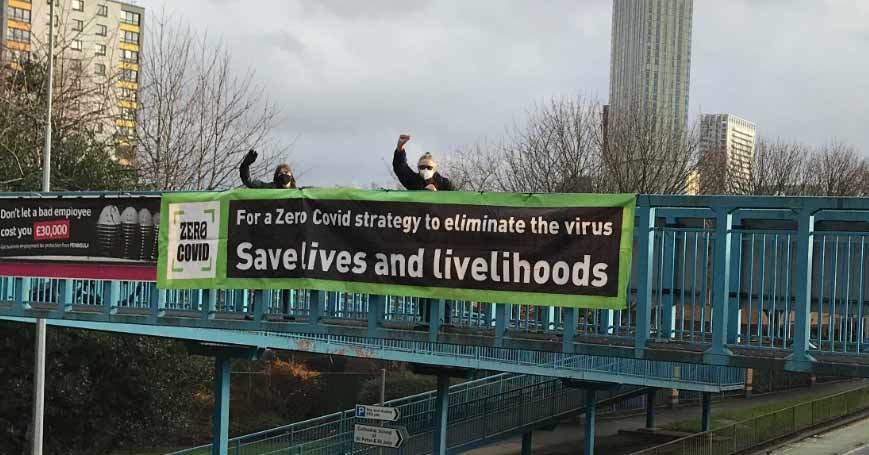

On January 26, the UK passed a very grim milestone: 100,000 deaths from covid-19. The figure also confirmed the country has the most deaths per capita in the world. Coming less than a year after chief scientific adviser Patrick Vallance emphasised the potential danger of the new virus by suggesting 20,000 would be a “good outcome”, this is a damning condemnation of Boris Johnson’s government. He and his government have blood on their hands.
At every stage, they have delayed action until there was no alternative. For several weeks after China had reported the new virus and its virulence to the world, Johnson did not even bother to attend meetings dealing with the subject. Only after the leaking of Professor Ferguson’s prediction of half a million dead if nothing was done, was he jolted into action.
Although the “first lockdown” from 23 March did serve to drive down the rate of infections, it was lifted after just six weeks. Far from using the opportunity to ensure an effective test and trace service, even the half-baked private enterprise scheme launched in early March was abandoned. Coupled with exhortations to the public to “Eat out to help out”, Johnson and his hapless ministers guaranteed a second wave as summer passed into autumn.
The clearest evidence that the government was not just caught unawares by a totally unpredictable turn of events, but was guilty of a wilful refusal to act came on 21 September. On that day, scientific advisors made public their advice that a second lockdown was immediately necessary to prevent a rapid escalation in the pandemic.
Johnson’s response was characteristically half-hearted and ineffectual: an extension of the “tiering system”. Once again, the demands of his most primitive backbenchers to “keep the economy open” counted for more than the clear conclusions of scientists.
Coincidentally, 21 September was also the day on which a routine swab test was taken from a patient in Kent. When analysed some weeks later, it was found to be a new variant of the virus. By mid-November, more and more examples of this variant (B117) were being found and it was confirmed that it was at least 30, perhaps as much as 70 per cent more transmissible than the original.
Even then, Johnson only agreed to a brief, three-week and far less rigorous lockdown, while assuring the public that there would be a major relaxation of restrictions over the Christmas “festive season”. Worse still, in the face of the rising infection rates, inevitable once lockdown was lifted, Johnson backed the actions of his witless Education Secretary Gavin Williamson, when he threatened local (Labour) councils with legal action if they persisted in closing schools.
And what of the Labour Party? Keir Starmer, sometimes laughably referred to as the Leader of the Opposition, as usual, immediately took sides – with the government. He did not just want the schools to open, he “expected” them to be open!
Now, of course, the Tories hope that the rollout of the vaccination campaign can be used to their advantage. The backbenchers and journalists are arguing that as soon as the most vulnerable have been vaccinated, probably by mid-February, the lockdown should be lifted. That would be disastrous; it will be many months before a majority of the population have been vaccinated and during that time, if there are fewer restrictions on movement, the virus will spread and, in all probability, mutate further, just as it did when lockdowns were released too early before.
We should not wait for Johnson and the cabinet to learn from past experience, but there are important lessons for the labour movement, too; in particular from the government U-turn on keeping schools open. Most importantly, it was school-based organisation that forced Williamson, just days after his threats of legal action, to accept that schools had to close.
More than that, it forced Johnson to bring in the current lockdown. The scale of the death toll finally ensured more media recognition of the great weight of scientific and medical opinion which was against Johnson. Through Independent SAGE and the Zero Covid Campaign, that message also finally began to reach the general public.
Just as with the first lockdown, it was only the prospect of a collapse of the health service that convinced Johnson to act. For all his crocodile tears and “we did everything we could” laments, by the time the numbers of dead reached 100,000, he had actually done nothing till after Christmas. It is now known that fully one third of the total, more than 30,000 people, died because of the refusal to lock down in September.
The schools were closed by workplace-based action for a clear demand, backed up by accurate and convincing scientific evidence. To deal with the pandemic at a national, indeed an international, level, we need to build on that experience. January’s conference of Zero-Covid called for local campaigns and actions in support of the key demands first raised by Independent SAGE: Find, Test, Trace, Isolate, Support.
Each of these is essential to suppress circulation of the virus but the demand for full pay for those who need to isolate should be raised immediately by all unions and can be taken up most easily by workplace organisation. Campaigning for that, as with the campaign to close schools, will have the added benefit of preparing for the onslaught on jobs and pay that is sure to follow the pandemic.